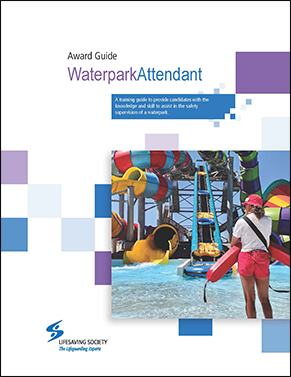The Lifesaving Society’s Waterpark Attendant certification is designed to provide candidates with the knowledge and skill to assist in the safety supervision of a waterpark.
Resources
As a result of this training program, candidates will understand:
- roles and responsibilities of a Waterpark Attendant
- how to identify, control and eliminate risks and hazards through facility analysis
- the role and rescue skills needed to respond to emergency situations
Prerequisites: Minimum 14 years of age, Emergency First Aid certification.
Evaluation and certification: Current Lifesaving Instructors teach and certify candidates.
Recertification: Waterpark Attendant is recertified by successfully completing a Waterpark Attendant course.
Candidate recognition: Certification card.
Required references: There are no required references for candidates. Use handouts or references as applicable.
:::

Instructor references: Instructors require the Waterpark Attendant Award Guide. Where applicable, reference provincial regulations (e.g., the Lifesaving Society’s Guide to Ontario Public Pools Regulation).
Technical resources that support test item content are listed in the bottom of the Notes column. CLM refers to Canadian Lifesaving Manual, CFAM refers to the Canadian First Aid Manual, Alert refers to Alert: Lifeguarding in Action.
Required equipment: Classroom supplies such as tables, chairs, flip chart paper, stand and markers, masking tape, and A/V equipment. First aid supplies including barrier devices, adult, child, and infant CPR training manikins, and AED Trainers.
Facility requirements: A pool with minimum width of 5 metres, a minimum length of 15 metres and includes an area with a depth between 1.0 metre and 1.5 metres deep.
At-A-glance
Knowledge items:
1. The Lifesaving Society: Demonstrate knowledge of the Lifesaving Society and awareness of its training program opportunities.
2. Theory and practice: Through practical activities, candidates demonstrate an understanding of the following in a waterpark setting:
- The role and responsibilities of the Waterpark Attendant.
- The roles and responsibilities during an emergency of waterpark lifeguards, supervisors, and emergency medical personnel.
- The legal obligations of the Waterpark Attendant in terms of duty and standard of care, liability and negligence.
- How government regulations, industry standards and employer policy and procedures affect the Waterpark Attendant’s job.
- The role of water treatment systems in providing a safe and comfortable environment.
- The hazardous nature of chemicals used in aquatic environments and the special training required for their safe handling.
- The cause and prevention of shallow water blackout.
- The administrative tasks that may be assigned to the Waterpark Attendant.
Physical Items:
3a. Physical standard: sprint challenge: Demonstrate anaerobic fitness: Starting in the water, swim 25 metres within 35 seconds (25 yards within 30 seconds).
3b. Physical standard: underwater swim and object recovery: Starting in the water, submerge and swim 10 metres underwater to retrieve a 4.5 kg (10 lb.) object; surface and return the object 10 metres to the start.
Skill items:
4. Communication: Demonstrate effective communication with patrons, victims, other attendants, lifeguards, supervisors and emergency service personnel.
5. Waterpark facility orientation: Demonstrate an understanding of:
- Features that vary from waterpark to waterpark or from time to time during hours of operation.
- Potential hazards in waterparks and amenities including waterslides, river rides, amusement devices and play structures.
- Basic operation of waterslides, amusement devices and play structures.
- Inspection procedures for waterslides, amusement devices and play structures.
- Common safety equipment.
:::
6. Monitoring waterpark features and amenities: Demonstrate an understanding of safety considerations and effective monitoring for waterpark features and amenities, including:
- Waterslides
- River rides
- Wading pools
- Play structures
7a. Surveillance: positioning and rotation: Demonstrate effective positioning and rotation.
7b. Surveillance: scanning and observation: Demonstrate effective observation skills and scanning techniques.
7c. Surveillance: prevention and intervention: Demonstrate an ability to recognize situations in which early intervention may prevent a rescue emergency.
8. Victim recognition: From land, demonstrate the ability to recognize the appearance of victim types common in waterparks.
9. Entries and removals: Demonstrate two entries and two removals (with assistance) appropriate for a waterpark environment, including a removal with a board.
10. Management of an injured victim: Demonstrate effective management of an injured victim.
11. Spinal injury management: Respond to a suspected spinal-injured victim located in shallow water and on land. Victim may be found breathing or non-breathing, face-up or face-down.
12. Drowning resuscitation: On a manikin, demonstrate single-rescuer adult, child, and infant drowning resuscitation including ability to deal with complications.
13. Rescue of non-breathing victim: Rescue a non-breathing victim located in the water. Remove victim with the assistance of one trained backup. Initiate CPR on a manikin (5 cycles of CPR as a single rescuer, followed by 5 cycles of 2-person CPR).